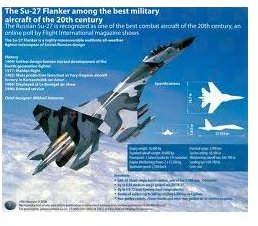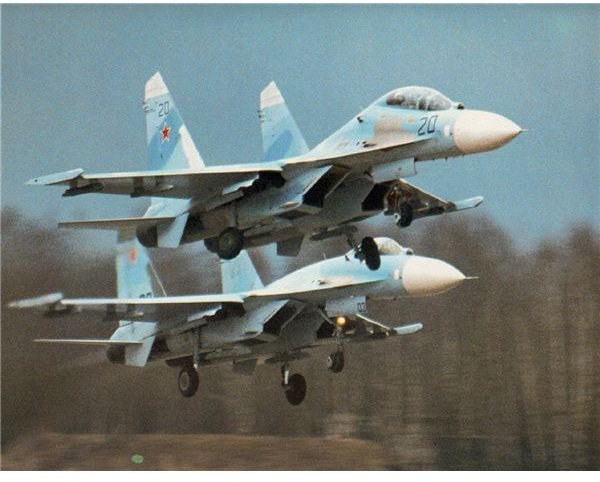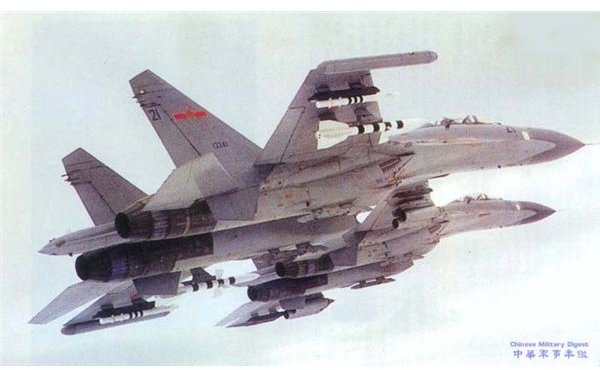The SU-27 Flanker: A Potent Russian Air Superiority Fighter
The Sukhoi SU-27 Flanker: Air Superiority Powerhouse
The SU-27 Flanker air superiority fighter was born out of a need for Soviet Frontal Aviation (Soviet Air Forces) and PVO (Soviet Air Defense Forces) to obtain an aircraft that could compete with the United States Air Force F-15 Eagle. After a long design period, the Soviet Union first deployed the SU-27 in active service in 1984.
Like the F-15, the SU-27 Flanker (Flanker being the NATO reporting designation, not a Russian name) was designed from the outset as a powerful air superiority fighter capable of dominating the airspace over the battle front and beyond. Unlike many previous Soviet fighter designs, the SU-27 was meant to fight and survive over a modern battlefield by leveraging superior technology rather than pure numbers and individual airframe maneuverability.
The SU-27 is still in service with the Russian Air Force and several Soviet successor states, including the Ukraine, Belarus, Kazakhstan, and Uzbekistan. In addition, both China and India have received SU-27 variants, and they are now those nations’ primary fighter aircraft.
SU-27 Flanker Design Specifications
There have been numerous upgrades and modifications to the SU-27 airframe since it was first operationally deployed in the 1980s, and the basic SU-27 airframe serves as the origin for several follow-on variants of the Flanker series, the Indian SU-30, Chinese J-11, Russian navy SU-33, and the newer SU-34 strike aircraft and SU-35 advanced fighter.

However, the base configuration of the Flanker results in an airframe that reasonably reflects these specifications, published by Sukhoi:
- Max takeoff weight of 33 tons, Max landing weight 25 tons.
- 72 feet long, 48 feet wingspan, 19 feet high.
- 10 tons of internal fuel and range of up to 2200 miles without refueling
- Maximum service ceiling of over 60,000 feet above sea level.
- Two engines each with 17,000 lbs of thrust, 27,000 on afterburner.
- Thrust to weight ratio of 1.09 and maximum speed of mach 2.35
- Wing loading of about 76 ft/Lbs squared.
- One 30mm cannon with 150 rounds.
- Up to six R27 (AA-10/AA-12) series and four R73 (AA-11) missiles.
- Ten external pylons capable of carrying over eight tons of ordnance.
The SU-27 Flanker is also equipped with a N001 (Nato reporting name Slot Back) radar and a helmet mounted heads up display which allows the pilot to target weapons without having to keep the nose of the aircraft pointed at an opponent. The SU-27 is composed of almost one third titanium, which raises the cost of the aircraft but also lends itself to increased survivability in combat.
Flanker in Combat - Tested and Lethal
The SU-27 never saw combat over Western Europe due to the Cold War coming to an end only five years after the fighter was introduced into service. However, variants of the aircraft have been used in several conflicts and military exercises that have vindicated its design.
The 2008 South Ossetia War saw significant use of the SU-27 Flanker by Russian forces against an opponent equipped with combat aircraft. And it performed extremely well, helping to secure the airspace over the South Ossetian capital city of Tskhinvali.
In a telling example of the Flanker’s superiority over its generational counterpart, the MiG-29 Fulcrum, Ethiopian SU-27 Flankers scored a number of victories without loss against Eritrean MiG-29s over the course of two years. Because the MiG-29 is generally assessed to be on par with the American F-16, and the MiG-29 relationship with the SU-27 is similar to that between the F-16 and F-15, this has interesting implications for any match up between the SU-27 and F-15, the encounter which the SU-27 Flanker was built to win.
One final note on the SU-27 Flanker’s potential lethality against US fighters: In 2004, the Indian Air Force and United States Air Force held joint exercises (Cope India) which pitted an export variant of the SU-27, the SU-30, against US pilots flying the F-15C. In a surprising turn of events, the Indian pilots in their Flanker fighters defeated their American counterparts in the majority of engagements.
So, with the operational history and specifications of the SU-27 Flanker in mind, it needs to be asked: could the maneuverable SU-27 defeat F-15 speed and technology?
SU-27 Defeat F-15?
Maneuverable SU-27 defeat F-15 technology? Could it happen?
The F-15 looks impressive on paper - it has a superior thrust to weight ratio and higher maximum speed. But the results of Cope India indicate that the Flanker’s base statistics do not tell the full story of its maneuverability - the Pugachev Cobra maneuver is routinely performed in the aircraft.
SU-27 Engages F-15: Closing
A thought experiment is needed: One of each aircraft is closing head on at an airspeed of 600 knots and an altitude of 30,000 feet. They detect one another on radar at the same time. Each aircraft is armed with a basic loadout of two radar guided missiles (AA-12 and AMRAAM) and two head seeking missiles (AA-11 and Sidewinder) plus internal guns.
The engagement begins at about 30 miles, when the F-15, reaches maximum operational range for its AMRAAM missiles.
If the F-15 can maintain lock-on and fire a missile, the engagement might be over. But the SU-27 Flanker pilot has some tricks to avoid this. The aircraft are closing at roughly 20 miles per minute, and the AA-12 missile on the SU-27 has a range of around 20 miles. The SU-27 has a helmet mounted heads up display - the F-15 must keep its nose pointed at an opponent to achieve lock-on, but the SU-27 pilot can maneuver to some degree. This is key to any SU-27 defeat F-15 scenario.

The SU-27 pilot will try to evade the F-15 lock on attempt, perhaps performing a Pugachev Cobra, which is known to confuse radar tracking systems. The goal is to buy thirty seconds so the SU-27 can launch its own missile.
It is probably a wash at best whether the SU-27 can avoid the F-15’s tracking system long enough to get off its own shot. Even then, avoiding the missile is another matter. It is more likely than not that the SU-27 is at best able to fire simultaneously with the F-15, forcing both to maneuver.
Flanker and Eagle - Dogfight!
In all likelihood, neither aircraft will maneuver to escape, because each would still be within the other’s missile envelope. They will both evade the onrushing missiles while trying to maneuver closer for another shot. The F-15 would rely on its electronic countermeasures and speed to get away by flying higher and faster away from the missile, and the SU-27 would use its maneuverability to turn tightly and throw off the AMRAAM.
Assuming both fighters evade, they would likely return to closing head on, with the Eagle slightly higher and moving at greater speed than the Flanker.
The SU-27, due to its helmet mounted HUD can attempt an off-boresight infrared missile shot as the fighters approached. IR missiles are less accurate when fired in this manner but this would at least disrupt the F-15’s approach.
The Eagle will probably overshoot the Flanker while evading, but as the F-15 has an acceleration advantage, it could try to keep the fight vertically oriented, looping high and work behind the Flanker. The SU-27 will probably try to remain in the horizontal plane, utilizing its superior turning radius to go for another off-boresight missile shot using the helmet mounted HUD. A stalemate would well ensue at this juncture where the Flanker continually turns inside the Eagle, but is unable to get off a shot while the Eagle maintains a speed and height advantage, unable to keep its nose on the SU-27
In all likelihood, such a battle would end when one pilot made a mistake. One thing is certain - the Flanker could possibly survive one mistake if it led to only the 20mm rounds from the F-15’s internal Gatling striking it, because titanium is a very difficult substance to penetrate. The Eagle would not survive a hit from the Flanker’s cannon - 30mm rounds would shred the F-15.
Conclusion: Could SU-27 Maneuverability Defeat F-15 Technology?

The F-15 has a definite advantage at long range, but in a dogfight, the SU-27 Flanker can likely win out over the F-15 Eagle.
In short, it is very possible for skilled pilots in the SU-27 to defeat F-15 Eagles - But the F-15 has one distinct advantage: it can end the fight before the SU-27 can fire a shot.
SU-27 Flanker: Sources
Sukhoi Design Bureau: SU-27 Aircraft Performance
https://www.sukhoi.org/eng/planes/military/su27sk/lth/
Andy Lightbody, Joe Poyer, Major Dick Cole; The Great Book of Fighter Planes, 1990 Beekman House ISBN 0517035987
Indian Air Force: Exercise Cope India 04
https://indianairforce.nic.in/show_page.php?pg_id=144
